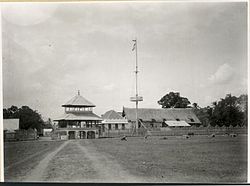Sultanate of Bima
| Sultanate of Bima | ||||||||||
| Kesultanan Bima Mbojo | ||||||||||
|
||||||||||
|
Bima Sultanate palace
|
||||||||||
| Capital | Bima | |||||||||
| Languages | Bima | |||||||||
| Religion | Islam | |||||||||
| Government | Sultanate | |||||||||
| Sultan | Sultan Abdul Kahir | |||||||||
| History | ||||||||||
| • | the King of Bima converted to Islam | 1620 | ||||||||
| • | kingdom status abolished by the Republic of Indonesia | 1958 | ||||||||
|
||||||||||
| Today part of |
|
|||||||||
The Sultanate of Bima was a Muslim state in the eastern part of Sumbawa in Indonesia, at the site of the present-day regency of Bima.
The Bima Kingdom was the forerunner of the Sultanate of Bima. The indigenous name for the kingdom is Mbojo. Local historical legends speak of two brothers, Indera Jambrut and Indera Kemala, who were sons of the mythical hero Bhima and a golden dragon woman and had supernatural powers. They arrived to Sumbawa from the island Satonda and were acknowledged as rulers of the land. There are few historical sources about Bima from the 15th and 16th centuries. At least by the 17th century, the system of government was partly adapted to the system prevailing in the Kingdom of Gowa on Sulawesi. Besides the Sangaji (king) and the Tureli Nggampo (executive regent), the administration of the kingdom included appointed Tureli (ministers), Jeneli (subdistrict chiefs), and Gelarang (village headmen). Shipping and commerce grew rapidly. While Java was the main cultural referent in the beginning, relations with South Sulawesi later became important. Ships and boats increased in number and quality and followed the patterns of navigation and commerce sustained by the Gowa empire.
With increased political integration of the kingdom, the security of the land was enhanced as well. The facilities of the army and marine, and the quality of the weaponry, were updated. An official called the Renda served as commander of the army. The navy was led by an admiral who was called Pabise. Thus, at the end of the 15th century the Kingdom of Bima Mbojo evolved into a crowded commercial center in the eastern archipelago, at the side of Gowa and Ternate. At that time, the Kingdom of Bima Mbojo was a storehouse of rice in the area, similar to Lombok.
The kingdom saw developments in the field of literature, art and culture. Manggampo Donggo introduced a writing system which had been learned from Gowa. It eventually became the system known as the Mbojo alphabet. Arts and culture of Gowa were studied and developed in the community. In that way Mbojo cultural arts were born, which had a lot of similarities with the arts and culture of Makassar and Bugis.
...
Wikipedia

